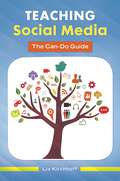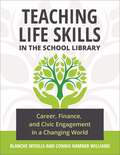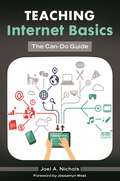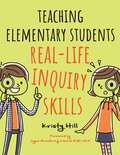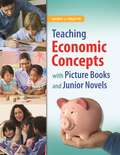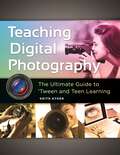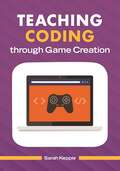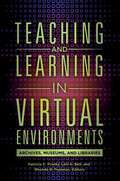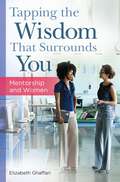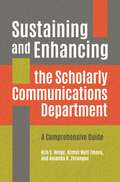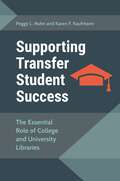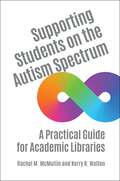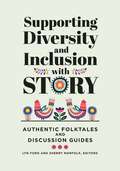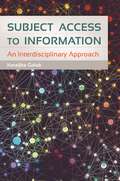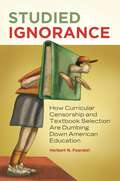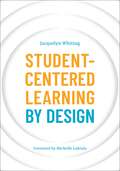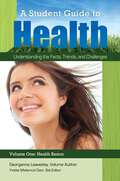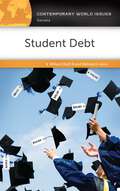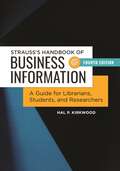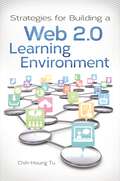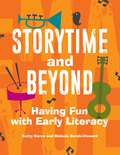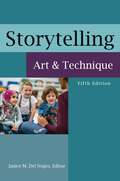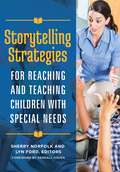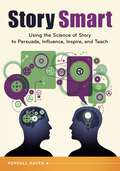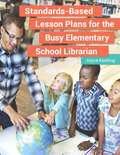- Table View
- List View
Teaching Social Media: The Can-Do Guide
by Liz KirchhoffLibrarians who want to begin, expand, or improve their programs on teaching social media to adults and teens will find this guide invaluable.Sharing social media expertise with library clientele is a natural way for libraries to support their communities—and increase their relevance. This book provides a roadmap for librarians who wish to offer this service but need to brush up on their own social media skills or learn how to cover the topics in a classroom situation.Although there are many books on social media, this volume is unique because it presents complete teaching scripts that can be adapted for various classroom situations along with general guidelines and tips. You'll find general advice on social media as well as suggestions for getting support for the program, creating a syllabus tailored to community needs, and planning class format and logistics. Entire chapters cover Twitter, Facebook, LinkedIn, Foursquare, Pinterest, Yelp, and Google+, explaining how these sites work and how to use them to your advantage, as well as some of the privacy and safety concerns surrounding them and how they are trending. Class variations such as Twitter for Business and How to Plan Your Trip Online are also discussed, as are other classes to consider—for example, Tumblr and Instagram—and how to develop them.
Teaching Life Skills in the School Library: Career, Finance, and Civic Engagement in a Changing World
by Blanche Woolls Connie Hamner WilliamsDrawing on stories from successful programs and research, this book shows librarians how to provide students with the practical information they need for a bright future. Chapters cover career readiness, financial literacy, and civic responsibility at each grade level.From preschool through high school, students are preparing for their future. As they move through grade levels, they choose courses, research potential careers, learn about managing money, and recognize the responsibilities of being active citizens. At each step of the way, librarians can collaborate with teachers to help students to learn how to live in a world they can only imagine. School librarians are positioned to make a positive impact on students' lives when it matters most. Focusing on preparation for life after high school, this book cites research and provides anecdotes of successful programs as examples of how school librarians, in collaboration with counselors, community members, public libraries, and teachers, can develop collections and offer programming to show students the importance of finishing high school. Chapters also explain how to help students to find the college or university that fits with their educational interests and won't cause them to incur enormous debt. Included in every chapter are activities, resources, and lesson plans around topics at each grade level for librarians to co-teach with teachers, counselors, and other school staff.
Teaching Internet Basics: The Can-Do Guide
by Joel A. NicholsPerfect for public librarians, instructional librarians, technology and digital resource specialists, and library training specialists, this book is an essential resource for digital literacy instruction.According to Pew research published in 2013, two-thirds of public libraries report that technology training is important in their communities, and that 86.5 percent of public libraries offer classes on general Internet use. Despite the ubiquitous nature of the Internet and digital media, digital literacy instruction remains one of the major job duties of 21st-century librarians. In this book, author Joel Nichols helps you to close the digital divide and make a difference in increasing information and digital literacy for your patrons, offering tested content and methods that will make it easier for librarians to provide effective digital literacy instruction.With its discussion of key Internet safety and security topics for inexperienced Internet users, this hands-on, practical guide is what you need for approaching—and solving—these digital literacy instructional challenges. This manual serves librarians who are teaching computer and Internet basics to patrons with little or no experience by providing a packaged solution with ready-made training scripts and practical examples that teach basic digital literacy techniques. The guide also fills any gaps in your knowledge or experience and gets you up to speed with the latest digital information needs of users in order to form a solid foundation from which to provide instruction with the supplied curriculum.
Teaching Elementary Students Real-Life Inquiry Skills
by Kristy HillFake news and misinformation is everywhere. Learn how to teach elementary students to locate reliable information, evaluate sources, and develop their writing skills in the classroom and in the library.Empower students to find and evaluate information with this practical guide to supporting classroom writing and research instruction. You'll learn ways to teach students to evaluate information for accuracy and to collect information from credible sources such as library journals. Additionally, you'll learn how to incorporate writing into your makerspace, encourage curiosity through the inquiry process, and help students to find their voice. Along the way, you'll discover how to support various writing genres including technical writing and the research project and how to teach prewriting for digital media such as websites, blogs, and social media.Lesson plans, which can be adapted from year to year as a part of the classroom and library curriculum, explain how students can use databases, search engines, books, and expert testimony to gather information. Also included are student samples and hands-on activities that will get students excited about learning.
Teaching Economic Concepts with Picture Books and Junior Novels
by Nancy J. PoletteUsing quality literature to introduce younger students to economic terms and concepts is an engaging and effective teaching method. This book demonstrates how.At what age can children benefit from learning about economics? The consensus among educators today is the earlier the better. K–8 teachers and librarians will find this book invaluable for introducing basic economic concepts to students and giving them a solid foundation of understanding that can be built upon as they advance in grade level. Author Nancy Polette, prolific author and expert on using picture books for education, explains how to use 20 picture books to present basic ideas such as credit, wants and needs, and supply and demand; and to build understanding of more complex concepts with 20 junior novels. The titles and suggested activities enable students to enjoy the literary experience and benefit from economic lessons that sink in because they are presented through stories involving characters with whom children can relate.
Teaching Digital Photography: The Ultimate Guide to 'Tween and Teen Learning
by Keith KykerThis book provides a full-year curriculum for educators wishing to teach a digital photography/multimedia class that will endow students with the technical skills for producing complex digital imaging projects.Digital imaging devices are everywhere, and most households have several—digital cameras, smartphones with cameras, and GoPro action cameras. With the right techniques and software, today's high-tech equipment can be used to create outstanding photographs or stunning digital imaging projects. This book allows any educator to teach digital photography/video and multimedia, regardless of previous experience with digital imaging, supplying tested and proven lesson plans, hands-on project ideas, and grading rubrics for a full-year course.Ideal for middle school, high school, and community college teachers as well as public youth services librarians, particularly those embracing the makerspace movement, Teaching Digital Photography: The Ultimate Guide to 'Tween and Teen Learning provides a detailed educational plan advising how to purchase equipment, set up a classroom or library area to be used for instruction, and instruct the students in the skills needed to become excellent digital photographers. The first half of the book focuses on establishing the class: the general philosophy, the classroom, and the equipment. Three chapters are dedicated to exploring the best ways to teach students the skills of photography, digital image improvement, and digital layout. The final sections of the book provide more than 20 digital layout projects and cover digital video production.
Teaching Coding through Game Creation
by Sarah KeppleThis engaging guide demonstrates how easy, fun, and rewarding it can be to teach and learn coding at the library.In our technology-obsessed society, computer coding is a highly valued and in-demand skill, but many people consider it an activity only for technology geeks and educated professionals—even more so to teach coding. Not so, says author Sarah Kepple. In this accessible guide, she explains why you don't have to be an expert to lead coding, shows how easy and rewarding learning and teaching coding can be, and provides step-by-step instructions to help you and your community get started. The book shows how to engage students quickly with learning activities that springboard off of the powerful appeal of video games. The author takes users through activities that introduce popular programming languages—including GameMaker, JavaScript, Python, and Scratch—to create video games, and in the process, to learn coding. These activities, themed around classic and popular stories, appeal to a broad age range—from elementary-age youth through high school and beyond to adults and seniors. Readers will see why school and public libraries are venues ideally suited for coding classes, workshops, clubs, or camps, and they will understand why teaching coding not only meets an important need but also serves to highlight the library's relevance to its community.
Teaching and Learning in Virtual Environments: Archives, Museums, and Libraries
by Patricia C. Franks, Lori A. Bell, and Rhonda B. Trueman, EditorsUseful to school librarians, teachers, and faculty, this book explains the range of possibilities for creating immersive learning experiences through the use of virtual worlds, virtual simulations, virtual collections, exhibits by libraries and museums, and archives.There is a renaissance occurring in education with immersive learning via virtual applications and environments, even at the elementary school level. This widespread new movement is happening over more platforms than before—Second Life, Open Sim, Unity3D, Curio, and others. Teaching and Learning in Virtual Environments: Archives, Museums, and Libraries presents readers with the scope of possibilities for education in virtual environments today. Written from the perspective of the practitioner, it provides a wealth of teaching tips for virtual environments and for combining virtual environments with other emerging technologies for libraries and education.Chapters describe how recent developments in technology have made web-based virtual worlds more accessible for teaching and learning and discuss the unique benefits and affordances of educating in virtual environments as well as their applications to different subjects. The teaching applications cover the primary and secondary school levels, higher education and graduate-level environments, and even beyond formal education into building immersive "information experiences" for professional training applications, library users, and the general public. The text provides an up-to-date overview for educators, academic and public librarians, and archives and museum staff on recent developments with immersive learning; presents innovative programs and teaching ideas; covers administrative issues; and addresses the student's perspective as well.
Tapping the Wisdom That Surrounds You: Mentorship and Women
by Elizabeth GhaffariAre you seeking the perfect mentor or life adviser—an ideal guide, no matter what the challenge? This book provides a unique and new road map for a modern world, demonstrating that the wisdom we seek surrounds us at every turn.As a professional speaker about leadership and as a coach and judge of entrepreneurial business competitions, author Elizabeth Ghaffari found that those seeking "a mentor, coach, or sponsor" often had no idea where to find such support—or knew what they needed to receive from such a relationship. In this book, readers will learn how to recognize invaluable mentorship and guidance all around them—from family members, at school, at work, in recreational and social settings, in the media and politics, and even from those who have left us. The true-life stories and testimonials presented will inspire and motivate you to endure, succeed, and prevail.This fun-to-read book contains the definitive answer to the question "How can I find a mentor?" as well as unique insights that young women can apply to transition into becoming successful leaders and define long-term success for themselves. Similarly, readers with more career experience will derive affirmation, motivation, and encouragement from peers as they chart their own leadership course.
Sustaining and Enhancing the Scholarly Communications Department: A Comprehensive Guide
by Kris S. Helge Ahmet Meti Tmava Amanda R. ZerangueLearn how to develop, manage, and maintain a scholarly communications department.More and more academic libraries are being asked to provide scholarly communications services to their campuses, ranging from general information about copyright law to instruction for creating and hosting digital repositories and publishing services. To support academic librarians and information specialists in starting their own scholarly communications departments, Sustaining and Enhancing the Scholarly Communications Department begins by introducing key scholarly communications concepts, including copyright, Creative Commons licenses, author rights, open access, open educational resources, open-access e-journals, and institutional repositories. Authors Helge, Tmava, and Zerangue explain how to develop, manage, market, and maintain a scholarly communications department. They define specific tasks and tools for which many scholarly communications departments are responsible, including intellectual property, licensing issues, promoting open access, data management, and plagiarism conundrums. They also discuss strategies for collaborating with key campus stakeholders and convey which academic degrees benefit and may be necessary for personnel in a scholarly communications department. Finally, the authors offer managerial and leadership techniques to increase employee productivity, efficiency, retention, motivation, and happiness within the scholarly communications department.
Supporting Transfer Student Success: The Essential Role of College and University Libraries
by Peggy L. Nuhn Karen F. KaufmannThis research-based book with practical applications teaches academic librarians to support their transfer students effectively at both universities and community colleges, even when transfer students' information literacy needs differ from those of other students.Colleges and universities across the United States serve a large and growing population of transfer students. Current estimates suggest that more than one third of college students transfer from one institution of higher education to another at least once. At some institutions, transfer students compose up to fifty to sixty percent of the new incoming class. Academic librarians' understanding of the demographics and potential needs of transfer students is essential to supporting their success and mitigating "transfer shock."Just as public libraries often bridge gaps between individuals and services, academic libraries can proactively support the often unique needs of transfer students by spearheading textbook affordability initiatives, developing innovative programming, and making appropriate referrals to non-library student services. In this practical guide to supporting transfer students, authors Peggy L. Nuhn and Karen F. Kaufmann teach academic librarians how to optimize information literacy instruction, support research, help reduce stress, and connect the library to virtual students. They emphasize the importance of establishing partnerships with feeder institutions and other campus departments to best support transfer student success.
Supporting Students on the Autism Spectrum: A Practical Guide for Academic Libraries
by Rachel M. McMullin Kerry R. WaltonThis book will be invaluable for those in the academic library who want to understand how best to serve students on the autism spectrum and how those students can contribute to the library.As a large number of students on the autism spectrum come of age and enter college, increased awareness of autism spectrum disorder is necessary among those who work in academic libraries so that they can respond to and meet the unique needs of these students. This book fills a scholarship gap while serving as a practical resource for working with the neurodivergent student population in academic libraries. McMullin and Walton explain issues that are likely to arise when interacting with students on the autism spectrum and offer practical solutions for handling them. They discuss how to work with neurodiverse students in different contexts, including at service points, in the classroom, as employees, and through outreach programs. They highlight possible concerns about the physical environment of the library and demonstrate ways that the library can be an especially positive place for students with ASD. Personal anecdotes from students with autism as well as library faculty and staff round out this valuable work.
Supporting Diversity and Inclusion with Story: Authentic Folktales and Discussion Guides
by Lyn Ford and Sherry NorfolkToday's increasingly interconnected and globalized world demands that students be taught to appreciate human diversity and recognize universally held values and beliefs. Authentic, culturally based folktales can lay the foundation for this cultural understanding.Professional storytellers like editors Sherry Norfolk and Lyn Ford are deeply committed to bringing people together through story. In this book, they have identified a group of culturally diverse storytellers whose carefully researched tales authentically reflect the cultures from which they come. The book includes well-crafted, culturally authentic folktales contributed by storytellers of varying cultures and ethnicities. Commentaries from the contributors follow each tale, reflecting on the story and its significance to the culture it represents. Sets of questions for teachers and librarians also accompany each story to facilitate discussion.Teachers, librarians, and information specialists find that stories engage students' attention and empathy. The commentaries provide insights into the significance of cultural norms, customs, and beliefs represented in the story, and the discussion questions and guides help them drill down with students to achieve deeper understanding. Resource lists of additional relevant materials at the end of each section promote continued learning.
Subject Access to Information: An Interdisciplinary Approach
by Koraljka GolubDrawing on the research of experts from the fields of computing and library science, this ground-breaking work will show you how to combine two very different approaches to classification to create more effective, user-friendly information-retrieval systems.A much-needed analysis of the intersection of information organization and technology, this interdisciplinary work encompasses both current and potential methods of organizing information by subject. It examines traditional approaches as they are used in the online environment and explores computer science approaches, such as ontologies and automated tools for subject information organization. Entries review the advantages and disadvantages of the two approaches, showcase their applications today, and project what those applications may be in the future.Content ranges from background on the importance of information organization in general to the importance of information organization by subject in particular. Traditional and modern knowledge-organization systems are covered, as are technological standards, selected topics in automated tools, and interdisciplinary research and cooperation. By tackling varied approaches, the work provides you with an appreciation of the tools—and an understanding of common aims.
Studied Ignorance: How Curricular Censorship and Textbook Selection Are Dumbing Down American Education
by Herbert N. FoerstelDespite concerted efforts from our educators, administrators, and government, American education continues to struggle. The author of this work argues that the decline can be traced to censored curricula, inaccurate textbooks, test-driven evaluations, and increasing poverty among the student population.Under the definition of "failure" specified in the No Child Left Behind Act, more than 80 percent of American schools could currently be labeled as failing, while the quality of American education overall and our students' performance continue to rank unfavorably against international competition. This book examines the crisis in American education and identifies how weaknesses in textbooks, teaching, and testing have created the crisis facing American education—a topic that dramatically affects students, teachers, and parents.Author Herbert N. Foerstel exposes the textbook "wars" that began a century ago and rage on with even more venom today. His book traces the legal basis for curricular censorship that dates back 75 years; identifies the bizarre process by which shoddy textbooks have been written, published, and come to be widely accepted; and documents the disastrous effect that reliance on these materials has had on the curriculum. Foerstel also supplies a careful assessment of the current political debate over education reform and of the proposed solutions to these problems.
Student-Centered Learning by Design
by Jacquelyn WhitingCurrent research is pushing schools to adopt more student-centered approaches to the classroom experience, and educators—librarians and classroom teachers alike—are being challenged to revise their curricula and instruction to be student-centered, personalized, and differentiated.This book empowers librarians, teachers, and administrators to be empathic problem-solvers and decision-makers. By reframing the challenges that members of a learning community face as opportunities to better meet teaching and learning needs, readers will find that adoption of a mindset focused on users—namely, design thinking—elevates and creates opportunities for innovating pedagogy. Moreover, it can enhance school culture as well as build channels of communication among various stakeholders in schools and districts.When educators of any subject or discipline apply design thinking skills to their curriculum implementation, authentic student-centered learning experiences become the core of the learning experience. The case studies shared in this book provide examples of student-centered approaches being used in elementary, middle, and high schools, so that readers have many models on which to base their work and from which to build confidence in shifting their pedagogy to keep the student at the center of teaching and learning decisions.
A Student Guide to Health [5 volumes]: Understanding the Facts, Trends, and Challenges [5 volumes]
by Georganna Leavesley Alice C. Richer Nancy A. Piotrowski Yvette Malamud OzerThis comprehensive, five-volume reference set is aligned with the National Health Education Standards, containing up-to-date, scientifically based information on a variety of health and wellness topics relevant to high school students.A Student Guide to Health: Understanding the Facts, Trends, and Challenges provides straightforward, factual, and accessible information about a multitude of health issues. It is an essential reference set that provides high school students, teachers, and administrators with a comprehensive health and wellness education resource that aligns with National Health Education Standards and common health curriculum. This expansive five-volume set is ideal for students' research projects; highly useful as a resource for community college and public library patrons, librarians, teens, and parents; and is a suitable supplement to any health education curriculum.Each chapter includes up-to-date, evidence-based information that provokes further examination and encourages critical thinking to evaluate the validity of information encountered about health and wellness topics. Each chapter provides an abundance of references and lists of resources for further information, including books, articles, websites, organizations, and hotlines. Special attention is paid to social trends that affect youth health and wellness, such as bullying, eating disorders, steroid abuse, sexting, and the peer pressure associated with drug use and abuse.
Student Debt: A Reference Handbook (Contemporary World Issues)
by William Elliott III Melinda K. LewisOffering answers to essential questions about student debt and many connected issues, this book examines student debt in the United States at every stage of the process—from the banks that issue the loans to the colleges and universities that collect the payments.Student lending in the United States is one of the most controversial issues in contemporary American discourse. Are these loans the only option for Americans who want to attend college and university in order to attain the best careers and have a productive, enjoyable life? Should the predatory lending practices of for-profit colleges and universities be stopped? How can limits be imposed on student lending amounts without preventing students from getting the education they need to succeed?The book explains why so many students are borrowing large amounts of money to attend college; considers whether the cost of higher education is simply too high, and if there should be a cap on how much money students can borrow; explains what is contributing to the rising rate of borrowers defaulting on their loans; and predicts whether the so-called student loan bubble is in danger of popping. The Data and Documents chapter analyzes data gathered from discussions about student debt. This information enables readers to better understand who is borrowing student loans, what the money from the student loans is going toward, what individuals have the authority to decide who qualifies for these loans, and what is being done to curb wasteful student spending.
Strauss's Handbook of Business Information: A Guide for Librarians, Students, and Researchers
by Hal P. KirkwoodThis new edition of Strauss's guide helps users to find current information for and about businesses of all kinds—both private and public, U.S.-based and international—related to finance, investment, industries, and entrepreneurship.Strauss's Handbook of Business Information is a resource for finding and understanding business information. It contains explanation and instruction on the key facets of business information and provides detailed descriptions of key resources within both broad and specific categories. It can be used as a guide to further understanding the what, how, and why of business information research.The changing arena of business information requires regular updating and awareness. This new edition has been thoroughly updated with three new chapters: Entrepreneurship, Competitive Intelligence, and Corporate Social Responsibility. Other additions of note include subsections on internet and mobile marketing and tax havens and related issues; coverage of new legislation (e.g., Dodd-Frank); and subsections on index funds, investment communities, regulatory bodies and laws, hedge funds, venture capital companies, assessing risks, robo-advisors, and more.The Handbook is for students, faculty, librarians, and information professionals looking to gain a broader and deeper understanding of business information. Anyone needing to gain quick exposure to business information needs and resources for solutions will benefit from the volume as well.
Strategies for Building a Web 2.0 Learning Environment
by Chih-Hsiun TuImagine replacing your current online Learning Management System (LMS) with social media and Web 2.0 tools! This book provides a comprehensive and easy-to-understand guide for making the most of the online learning environment.The integration of Web 2.0 tools into an online learning environment requires more than just connecting technology: it involves a paradigm shift from "online learning" to "open network learning." Strategies for Building a Web 2.0 Learning Environment provides a comprehensive and effective guide for teachers and trainers interested in integrating the concept of Personal Learning Environment (PLE) and Open (or Social) Network Learning Environment (ONLE) into any learning environment that utilizes online instruction. Rather than focusing on esoteric theory, the book offers a design model, practical guidelines, and sample activities that are based on current, well-grounded frameworks as well as the author's extensive online teaching experiences and personal research. Classroom teachers, school administrators, online learning researchers, corporate trainers, and corporate administrators will find that the innovative ideas set forth in this book are accompanied by practical guidelines for implementation.
Storytime and Beyond: Having Fun with Early Literacy
by Kathy Barco Melanie Borski-HowardJoin the world of balloons, pancakes, and musical instruments—just a few items to help improve early literacy in the library, the classroom, and at home. Literacy-builders covered range from music and instruments to magnetic letters, alphabet beads, and food.Literacy is a popular topic of discussion among librarians. Especially important is "early literacy," what children know about reading and writing before they can actually read and write. In this book, experienced librarians Kathy Barco and Melanie Borski-Howard share hands-on techniques that they have used to successfully promote early literacy and encourage family involvement. Storytime and Beyond teaches readers how to use "literacy doodads"—inexpensive props that add excitement to storytimes and can be used outside the library or classroom—to enhance the basic components of any early literacy program: talking, singing, reading, writing, and playing. Many of the doodads can be created as family do-it-yourself projects, and some can be adapted to work with non-readers of any age. Instruments can also be a great way to get children's attention and teach literacy skills, whether it's a drum to beat while reading a story or a maraca for children to shake during a song, and lesson plans for musical storytimes address how to use rhythm, singing, and dancing to make early literacy fun.
Storytelling: Art and Technique
by Janice M. Del NegroThis book serves as both a textbook and reference for faculty and students in LIS courses on storytelling and a professional guide for practicing librarians, particularly youth services librarians in public and school libraries.Storytelling: Art and Technique serves professors, students, and practitioners alike as a textbook, reference, and professional guide. It provides practical instruction and concrete examples of how to use the power of story to build literacy and presentation skills, as well as to create community in those same educational spaces.This text illustrates the value of storytelling, covers the history of storytelling in libraries, and offers valuable guidance for bringing stories to contemporary listeners, with detailed instructions on the selection, preparation, and presentation of stories. It also provides guidance around the planning and administration of a storytelling program. Topics include digital storytelling, open mics and slams, and the neuroscience of storytelling. An extensive and helpful section of resources for the storyteller is included in an expanded Part V of this edition.
Storytelling Strategies for Reaching and Teaching Children with Special Needs
by Sherry Norfolk and Lyn FordThis book supplies stories, essays, lesson plans and specialized storytelling strategies to help teachers "level the playing field" for all learners and better serve children with special needs.More than 57 percent of the over 6 million American children with disabilities are in inclusive (i.e., general) classrooms; "self-contained" classrooms serve children whose disabilities are either more severe or disruptive. As much as 20 percent of the children in an inclusive classroom are identified as "disabled," with the highest percentage of these having learning disabilities. While most classrooms have at least one child with a disability, teachers often have little or no training in educating and caring for these children. The need for resources that support educators working with children with disabilities or social/emotional difficulties is clear. This book fills this critical need, supplying school and public librarians, classroom and special area teachers, and storytelling teaching artists with storytelling strategies for reaching and teaching children with special needs in inclusive classrooms, self-contained classrooms, and public and school libraries. These full-text stories, essays, and lesson plans from experienced storytelling teaching artists provide educators with a wide range of adaptable storytelling and teaching strategies for specific disabilities and enable storytellers to discover news ways to perform their storytelling magic. The book also offers compelling real-life anecdotes that demonstrate the impact of these strategies in inclusive and self-contained classrooms; presents an introduction to the skills of storytelling, why they are useful, and how to use them; and includes suggested modifications for a wide range of disabilities as well as detailed resource lists.
Story Smart: Using the Science of Story to Persuade, Influence, Inspire, and Teach
by Kendall HavenThis one-of-a-kind book reveals the secrets of a story's power to persuade, inspire, influence, and to teach.Our brains have been evolutionarily hardwired to think, to make sense, and to understand in simple—but hidden—story terms. You'll discover the Neural Story Net, the Make Sense Mandate, Motive Matching, and the Story Influence Line—and understand how these powerful concepts control listener/reader engagement, attention, and the impact your communications will exert. You'll learn that what reaches the conscious mind of your target audience is significantly different from what first reached their eyes and ears—and that you can control that internal, neural process.This easy to use guide is organized into four parts: the neuroscience of narrative; your story tools; how narratives exert influence (changing beliefs, attitudes, values, etc.); and the straightforward process of creating "Story Smart" stories.
Standards-Based Lesson Plans for the Busy Elementary School Librarian
by Joyce KeelingThis helpful resource provides all-new tested, standard-based lessons accompanied by reproducible handouts and easy-to-follow directions.A new book by Joyce Keeling, an elementary librarian and teacher with more than two decades' experience, Standards-Based Lesson Plans for the Busy Elementary School Librarian presents many integrated lesson plans for students in each of the elementary grades, kindergarten through 5th grade. All lessons have been tested and refined in a school setting, and they are specifically written to match the AASL Information Literacy Standards, the McREL Compendium of Standards and Benchmarks, and the Common Core State Standards. In addition to the reproducible lesson plan worksheets, the book offers in-depth discussion of how best to collaborate to teach information literacy within the scope of common elementary school curricula.
